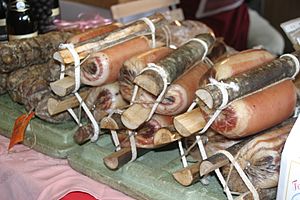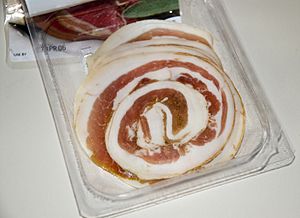Pancetta facts for kids

Rolled smoked pancetta
|
|
| Type | Cured meat |
|---|---|
| Place of origin | Italy |
| Main ingredients | Pork belly |
| Ingredients generally used | Salt, sugar, and spices |
Pancetta is a special kind of meat from Italy. It's made from pork belly, which is the same part of the pig that bacon comes from. Pancetta is unique because it's salt-cured. This means it's preserved with salt and other spices. In Italy, people often use pancetta to add a rich, savory flavor to dishes like soups and pasta.
Contents
How Pancetta is Used
Pancetta is very versatile in the kitchen. For cooking, it is often cut into small cubes, which Italians call cubetti di pancetta. These cubes can be fried until crispy and added to many recipes.
In Italy, pancetta is also enjoyed in thin slices, similar to lunch meat. People often eat it raw as part of an appetizer or in a sandwich. It's also a key ingredient in famous pasta dishes like carbonara, though some traditional recipes use a similar meat called guanciale.
Different Kinds of Pancetta
There are two main types of pancetta, based on how they are shaped:
- Rolled Pancetta (arrotolata) is shaped into a tight roll. This type is usually sliced very thin and eaten raw. It's popular in northern Italy. Sometimes, another meat called capicola is added to the center of the roll, creating pancetta coppata.
- Flat Pancetta (stesa) is left flat. This type is often chopped into pieces and used as an ingredient in many cooked recipes. It can also be cut into thicker strips and grilled. Flat pancetta is more common in central and southern Italy.
Most pancetta is just salt-cured and dried. However, there is also pancetta affumicata, which means "smoked pancetta." This kind is salt-cured and then smoked, making it quite similar to bacon.
What Pancetta is Made Of
Pancetta is made from pork belly. To cure it, the pork belly is soaked in a special mixture called a brine. This brine usually contains salt, sugar (like dextrose), and different spices. Common spices include black pepper, chilli, garlic, juniper, and rosemary. Ingredients like sodium nitrate and sodium nitrite are also used to help preserve the meat and give it its color and flavor.
How Pancetta is Made
Making pancetta is a careful process that takes several weeks:
- Preparing the Pork: First, the skin is removed from the pork belly. Then, the meat is placed in a tub of brine for about 10 to 14 days. This happens in a cool, humid place.
- Rolling and Shaping: After brining, the pork is rolled up tightly. The fatty parts are usually on the outside, with the meaty part in the middle. It's then put into a netting or casing to keep its shape. This rolling gives pancetta its unique look and helps it dry properly.
- Flavor and Color: The rolled pork is then kept in a warm place (around 22–24 °C) for a day or two. During this time, special natural changes happen in the meat. It might also be exposed to cold smoke. This smoking helps create the desired colors and flavors and prevents mold.
- Drying: Finally, the smoked pork is moved to a cooler place (12–14 °C) with controlled humidity. It stays there for 3 to 4 weeks to dry. By the end of this process, the pancetta has lost about 30% of its original weight.
Keeping Pancetta Fresh
Pancetta stays fresh for a long time because it is cured. Curing uses salt and special ingredients like nitrates or nitrites. These ingredients help remove extra moisture from the pork, which stops harmful tiny living things (microorganisms) from growing. They also prevent serious food illnesses like botulism.
Other spices in the curing mix also help preserve pancetta. For example, black pepper can act like a natural antibiotic, and sodium erythorbate is an antioxidant.
If you keep pancetta in its original sealed package, it can last for up to a year. Once you open it, you should keep it in the refrigerator for about 2 to 3 weeks. You can also freeze it for up to 3 months.
Pancetta and Your Health
Pancetta, like many cured meats, has some important nutrients but also things to be aware of:
- Protein and Fat: A small serving of pancetta (about 30 grams) has around 5 grams of protein and 11 grams of fat. It also contains a small amount of cholesterol. Even with its fat content, pancetta often has less fat than some other bacon products.
- Sodium: Pancetta contains a good amount of sodium (salt). Processed meats are a big source of sodium in people's diets.
- Other Nutrients: Pancetta has very small amounts of carbohydrates and no dietary fiber. The exact amounts of nutrients can change depending on how the pancetta is made and cooked.
Rules for Pancetta
Different countries have rules about how pancetta is made and labeled:
- In Canada, cured meats like pancetta must be prepared with salt and a certain amount of sodium nitrate or potassium nitrate.
- In the United States, the Food Safety and Inspection Service (part of the USDA) says that hormones are not allowed in pigs raised for food. So, pork sold in the U.S. must be labeled as "hormone-free."
- In the European Union, there are special rules for labeling pancetta. Only pancetta made in the Calabria region of Italy can be called pancetta di Calabria. This is part of a system that protects traditional food names.
Images for kids
See also
 In Spanish: Pancetta para niños
In Spanish: Pancetta para niños




